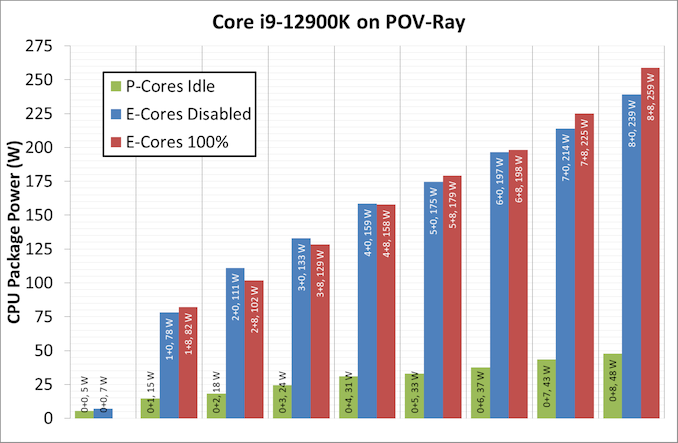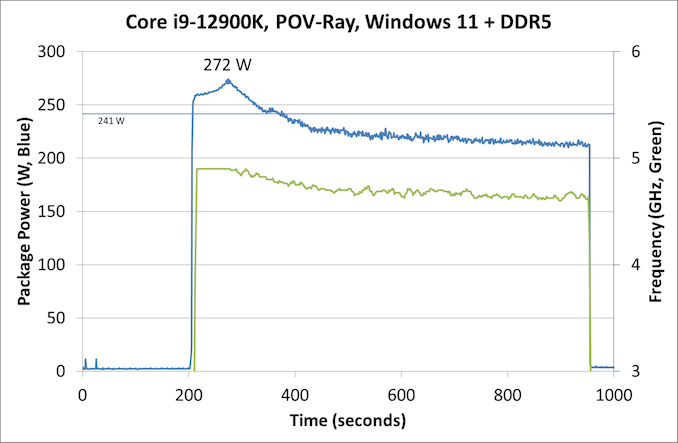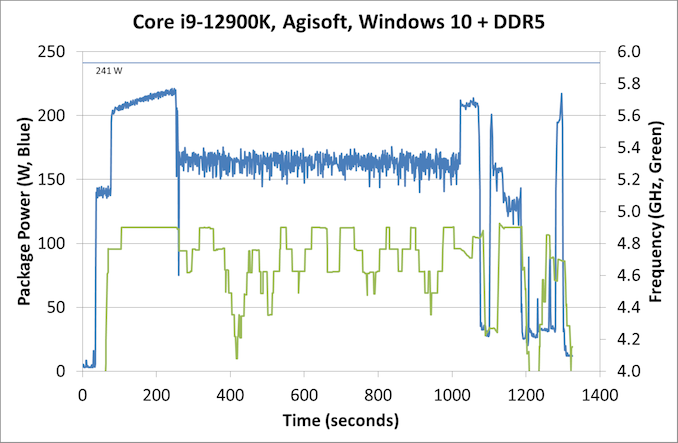The Intel 12th Gen Core i9-12900K Review: Hybrid Performance Brings Hybrid Complexity
by Dr. Ian Cutress & Andrei Frumusanu on November 4, 2021 9:00 AM ESTPower: P-Core vs E-Core, Win10 vs Win11
For Alder Lake, Intel brings two new things into the mix when we start talking about power.
First is what we’ve already talked about, the new P-core and E-core, each with different levels of performance per watt and targeted at different sorts of workloads. While the P-cores are expected to mimic previous generations of Intel processors, the E-cores should offer an interesting look into how low power operation might work on these systems and in future mobile systems.
The second element is how Intel is describing power. Rather than simply quote a ‘TDP’, or Thermal Design Power, Intel has decided (with much rejoicing) to start putting two numbers next to each processor, one for the base processor power and one for maximum turbo processor power, which we’ll call Base and Turbo. The idea is that the Base power mimics the TDP value we had before – it’s the power at which the all-core base frequency is guaranteed to. The Turbo power indicates the highest power level that should be observed in normal power virus (usually defined as something causing 90-95% of the CPU to continually switch) situation. There is usually a weighted time factor that limits how long a processor can remain in its Turbo state for slowly reeling back, but for the K processors Intel has made that time factor effectively infinite – with the right cooling, these processors should be able to use their Turbo power all day, all week, and all year.
So with that in mind, let’s start simply looking at the individual P-cores and E-cores.
Listed in red, in this test, all 8P+8E cores fully loaded (on DDR5), we get a CPU package power of 259 W. The progression from idle to load is steady, although there is a big jump from idle to single core. When one core is loaded, we go from 7 W to 78 W, which is a big 71 W jump. Because this is package power (the output for core power had some issues), this does include firing up the ring, the L3 cache, and the DRAM controller, but even if that makes 20% of the difference, we’re still looking at ~55-60 W enabled for a single core. By comparison, for our single thread SPEC power testing on Linux, we see a more modest 25-30W per core, which we put down to POV-Ray’s instruction density.
By contrast, in green, the E-cores only jump from 5 W to 15 W when a single core is active, and that is the same number as we see on SPEC power testing. Using all the E-cores, at 3.9 GHz, brings the package power up to 48 W total.
It is worth noting that there are differences between the blue bars (P-cores only) and the red bars (all cores, with E-cores loaded all the time), and that sometimes the blue bar consumes more power than the red bar. Our blue bar tests were done with E-cores disabled in the BIOS, which means that there might be more leeway in balancing a workload across a smaller number of cores, allowing for higher power. However as everything ramps up, the advantage swings the other way it seems. It’s a bit odd to see this behavior.
Moving on to individual testing, and here’s a look at a power trace of POV-Ray in Windows 11:
Here we’re seeing a higher spike in power, up to 272 W now, with the system at 4.9 GHz all-core. Interestingly enough, we see a decrease of power through the 241 W Turbo Power limit, and it settles around 225 W, with the reported frequency actually dropping to between 4.7-4.8 GHz instead. Technically this all-core is meant to take into account some of the E-cores, so this might be a case of the workload distributing itself and finding the best performance/power point when it comes to instruction mix, cache mix, and IO requirements. However, it takes a good 3-5 minutes to get there, if that’s the case.
Intrigued by this, I looked at how some of our other tests did between different operating systems. Enter Agisoft:
Between Windows 10 and Windows 11, the traces look near identical. The actual run time was 5 seconds faster on Windows 11 out of 20 minutes, so 0.4% faster, which we would consider run-to-run variation. The peaks and spikes look barely higher in Windows 11, and the frequency trace in Windows 11 looks a little more consistent, but overall they’re practically the same.
For our usual power graphs, we get something like this, and we’ll also add in the AVX-512 numbers from that page:

Compared to Intel’s previous 11th Generation Processor, the Alder Lake Core i9 uses more power during AVX2, but is actually lower in AVX-512. The difficulty of presenting this graph in the future is based on those E-cores; they're more efficient, and as you’ll see in the results later. Even on AVX-512, Alder Lake pulls out a performance lead using 50 W fewer than 11th Gen.
When we compare it to AMD however, with that 142 W PPT limit that AMD has, Intel is often trailing at a 20-70 W deficit when we’re looking at full load efficiency. That being said, Intel is likely going to argue that in mixed workloads, such as two software programs running where something is on the E-cores, it wants to be the more efficient design.














474 Comments
View All Comments
Wrs - Saturday, November 6, 2021 - link
Nah, they just weren't that competitive. Athlon64 was decent (lot of credit to Jim Keller) but didn't let AMD take massive advantage of Intel's weakness during the Pentium 4 era because AMD fabs were capacity limited. Once Conroe came out mid 2006 the margins dried up rapidly and AMD had no good response and suffered a talent exodus. It's true Intel made it worse with exclusivity bonuses, but I think AMD's spiral toward selling their fabs would have happened anyway. No way they were going to catch up with tick-tock and Intel's wallet.GeoffreyA - Monday, November 8, 2021 - link
I've always felt the K10 wasn't aggressive enough, owing to AMD not having factored Conroe into their equations when K10 was designed. Then, like startled folk, they tried to take back the lead by a drastic departure in the form of Bulldozer; and that, as we know, sank them into the ditch. Nonetheless, I'm glad they went through the pain of Bulldozer: Zen wouldn't have been as good otherwise.mode_13h - Tuesday, November 9, 2021 - link
> FX series was as bad as it was for a couple of reasonsI thought I also heard they switched from full-custom layout to ASIC flow (maybe for the sake of APUs?). If so, that definitely left some performance on the table.
bunnyfubbles - Thursday, November 4, 2021 - link
3D v-cache will be out before Zen 4 and should help close the gap if not regain the overall lead on the high end. The problem for AMD is the competition below the i9 vs R9 realm, where the E cores really pull more than their weight and help the i9 compete with the R9s in multi, but for the i5s and i7s vs their R5 and R7 counterparts, its even-Steven with performance cores, then you have the E cores as the trump card.MDD1963 - Thursday, November 4, 2021 - link
If AMD gains an averge of ~10% in gaming FPS with the 3D cache onslaught, that should put them right back near the top...certainly much closer to the 12900K....geoxile - Thursday, November 4, 2021 - link
15% on average. 25% at the highest. Intel really should have offered a 16 P-core die for desktop smdh, classic intel blunderSpunjji - Friday, November 5, 2021 - link
That would be a hell of a large die and necessitate a total redesign of the on-chip fabric. I don't think it would really make any sense at all.RSAUser - Monday, November 8, 2021 - link
12900K is already huge, each performance core is the size of about 4 E cores, going 16C P-Core would probably mean a 70% die size increase, and then you run into core to core communication issues, AMD got around it with infinity fabric but that's why you have the higher latency access between cores in different core complexes and Intel gives a more consistent access time on higher end products. Intel's current cores are mosly ringbus, so travel from one core to the next, getting to 16 doesn't scale well, they used a mesh topology in some Skylake CPU's, that latency was too high and hampered performance badly, you'd run into that same issue with 16C.That's without checking into yield, getting 16C on one wafer that are all perfectly clocking high is going to be a very, very rare chip; AMD gets around it using the core complexes (CX) of 4 cores each, together into a CCD (core chiplet die) and then in Zen 3 (5000 series) is supposedly 8C CCX, which makes rare chips 8C if full ccx works well, else 6C if 2 can't make it turns into a 5600X.
StevoLincolnite - Friday, November 5, 2021 - link
AMD has an answer before Zen 4.And that is Zen 3 with V-Cache.
Spunjji - Friday, November 5, 2021 - link
"This is their Zen 1 moment"Indeed!
"at a lower price"
Not really, if you take platform into account (and you have to!)
"Zen 4 isnt even competing with Alder Lake, Raptor Lake is rumored to be out before Zen 4"
Potentially, but Zen 4 is a bigger jump from Zen 3 than Raptor is predicted to be from Alder. Raptor will have more E cores but it's on the same process, so it's likely to offer better perf/watt in multithreading but unlikely to increase overall performance substantially (unless they allow maximum power draw to increase).
"AMD has really screwed up with their launch cycle"
Not really? They're still competitive in both price/performance (accounting for platform cost) and perf/watt. Zen 3D should shore up that position well enough.
"Intel is truly back"
Yup!